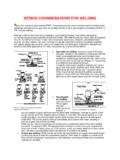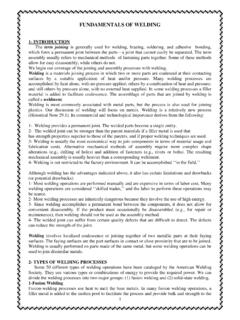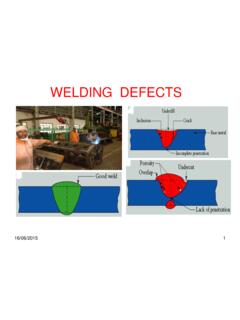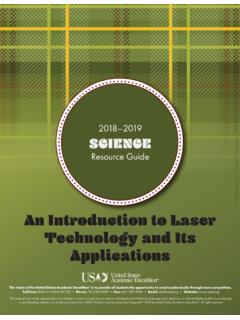Transcription of Fabrication and W elding
1 Fabrication and welding EngineeringThis page intentionally left blank Fabrication and welding EngineeringRoger Timings AMSTERDAM BOSTON HEIDELBERG LONDON NEW YORK OXFORDPARIS SAN DIEGO SAN FRANCISCO SINGAPORE SYDNEY TOKYON ewnes is an imprint of Elsevier Newnes is an imprint of Elsevier Linacre House, Jordan Hill, Oxford OX2 8DP, UK 30 Corporate Drive, Suite 400, Burlington, MA 01803, USA Copyright 2008 Roger Timings, Published by Elsevier Ltd. All rights reserved The right of Roger Timings to be identifi ed as the author of this work has been asserted in accordance with the Copyright, Designs and Patents Act 1988 No part of this publication may be reproduced, stored in a retrieval system or transmitted in any form or by any means electronic, mechanical, photocopying, recording or otherwise without the prior written permission of the publisher Permissions may be sought directly from Elsevier s Science & Technology Rights Department in Oxford, UK: phone ( 44) (0) 1865 843830; fax ( 44) (0) 1865 853333; email.
2 Alternatively you can submit your request online by visiting the Elsevier web site at , and selectingObtaining permission to use Elsevier material Notice No responsibility is assumed by the publisher for any injury and/or damage to persons or property as a matter of products liability, negligence or otherwise, or from any use or operation of any methods, products, instructions or ideas contained in the material herein. British Library Cataloguing in Publication Data A catalogue record for this book is available from the British Library Library of Congress Cataloguing in Publication Data A catalogue record for this book is available from the Library of Congress ISBN: 978-0-7506-6691-6 Typeset by Charon Tec Ltd., A Macmillan Company. ( ) Printed and bound in Hungary 08 09 10 11 12 10 9 8 7 6 5 4 3 2 1 For information on all Newnes publications visit our web site at Contents Preface ixAcknowledgements of fi gures and tables xi1 Health and safety1 Health, safety and the law 2 Employers responsibilities 4 Employees responsibilities 5 Electrical hazards 6 Fire fi ghting 7 Fire precautions and prevention 10 Accidents 11 First aid 14 Personal protection 16 Hazards in the workplace 19 Manual lifting 23 Mechanical lifting equipment 26 Use of lifting equipment 31 Accessories for lifting gear 32 Useful knots for fi bre ropes 35 Inspection (lifting equipment) 37 Oxy-acetylene welding 37 Arc- welding equipment (mains operated)
3 43 Working on site 50 Exercises 532 Personal development57 Basic relationships 58 Relationship with managers, supervisors and instructors 59 Attitude and behaviour 61 Implementing company policy 62 Creating and maintaining effective working relationships with other people 64 Exercises 663 Engineering materials and heat treatment69 States of matter 70 Properties of materials 70 Classifi cation of materials 77 Ferrous metals (plain carbon steels) 77 Ferrous metals (alloy steels) 80 Ferrous metals (cast irons) 81 Abbreviations 81 Non-ferrous metals and alloys 81 The identifi cation of metals 86 Non-metals (natural) 86 Non-metals (synthetic) 86 Forms of supply 88 Heat treatment processes (introduction) 91 Heat treatment processes (safety) 92 The heat treatment of plain carbon steels 93 The heat treatment of non-ferrous metals and alloys 100 Heat-treatment furnaces 102 Temperature measurement 105 Atmosphere control 108 Exercises 109 4 Using and communicating technical information111 Selection of information sources 112 Interpretation of information (graphical) 112 Interpretation of information (tables, charts and schedules) 116 Evaluating engineering information 118 Recording and processing engineering information 119 Methods of record keeping 121 Communications (miscellaneous) 121 Engineering drawing (introduction)
4 124 First angle orthographic drawing 125 Third angle orthographic drawing 127 Conventions 129 Redundant views 132 Dimensioning 132 welding symbols 136 The development of surfaces 137 Interpenetration 151 Pictorial views 153 Exercises 155 5 Measuring and marking out161 Introduction 162 Linear measurement 162 Angular measurement 169 Correct use of measuring equipment 171 Marking out equipment (tools for making lines) 172 vi Contents Marking out equipment (tools for providing guidance) 177 Marking out equipment (tools for providing support) 181 Techniques for marking out 183 The need for templates 192 The manufacture of templates 192 The use of templates 195 Condition and care of equipment 206 Exercises 2086 Material removal211 Cutting tool principles 212 The application of basic cutting tool angles to hand tools 214 Drilling, drilling machines and routing 226 Shearing sheet metal 239 Portable power tools 249 Blanking (stamping and piercing) 259 Flame cutting 263 Exercises 2757 Sheet and plate metalwork277 Sheet and plate metalwork (introduction)
5 278 Roll-bending sheet metal and plate 296 Flow forming sheet metal 301 The principles of metal spinning 318 Swaging sheet metal 324 Basic Fabrication procedures 330 Exercises 3458 Structural steelwork and pipework347 Rolled steel sections 348 Typical structural steel connections and assemblies 348 Trusses and lattice frames 353 Web stiffeners 356 Fabricated lightweight beams 359 Castellated beams 359 Pipework (setting out bends) 362 Pipe bending 366 Pipe fi tting 373 Exercises 3829 Joining processes (mechanical connections)385 Mechanical connections (threaded) 386 Hand reamers and reaming 404 Riveted joints 405 Pop Diveting 411 Self secured joints 418 Folding and jointing allowance 421 The Pittsburgh lock 425 Exercises 428 Contents vii10 Joining processes (soldering, brazing and braze- welding )429 Soft soldering 430 Soft-soldered joints using lead-free solders 445 Hard soldering (brazing) 447 Aluminium brazing 457 Types of brazed joints 460 Braze- welding 460 Exercises 466 11 Joining processes ( welding )467 Fusion welding 468 Oxy-acetylene welding 468 Manual metal-arc welding 490 Workshop testing of welds 504 Miscellaneous fusion welding processes 506 Workholding devices for fusion welding 509 Resistance welding 515 Further welding processes 518 Exercises 519 12 Composite Fabrication processes and adhesive bonding521 Introduction 522 Lamination 522 Fibre reinforcement 525 Particle reinforcement 531 The manipulation and Fabrication of polymers (plastics)
6 533 Adhesive bonding 540 Adhesive bonding of metals 545 Exercises 554 Appendix A 555 Index 557 viii Contents Preface This book is designed to provide an accessible course in the basic sheet-metal fabri-cation and welding engineering principles and applications required in a wide range of vocational courses. No prior knowledge of sheet-metal Fabrication and welding is assumed. I trust that Fabrication and welding Engineering will be found to be a worthy complement to my previous books on the fundamentals of general and mechani-cal engineering. As well as offering up-to-date best practice and technical informa-tion, this new title has been fully matched to the latest courses, in particular Level 2 NVQs in Performing Engineering Operations from EAL and the City & Guilds.
7 Guidance on the depth of treatment has been taken from the SEMTA National Occupational Standards on which all NVQs are based. The book is especially useful for trainees who are involved in a SEMTA Apprenticeship in Engineering. All of the chapters end with a selection of exercises. These will help with assess-ing the trainees performance criteria for the underpinning knowledge and under-standing that is an essential part of their training. The book ends with an Appendix of useful websites on the more advanced aspects of welding and profi le cutting involving: plasma arc welding ; electron beam welding ; laser welding and cutting and automated (robotic) welding and cutting (CNC). I also wish to pay tribute to the late Mr Smith who collaborated with me on matters of sheet-metal working and welding where this topic area occurred in my previous books. I have drawn heavily on his expertise in this current book.
8 X Preface Finally, the author and publishers are grateful to SEMTA, Pearson Educational Ltd for allowing me to quote extensively from Smith s book Fundamentals of Fabrication and welding Engineering , Henkel Loctite, Tucker Fasteners Ltd and all the other companies and organizations listed under acknowledgements for allowing the reproduction and adaptation of their illustrations and material in this text. Roger Timings Acknowledgements of fi gures and tables The author is indebted to Mr Bob Goss, Senior Technology Specialist at Henkel Loctite Adhesives Limited for his assistance in compiling the information on adhesive bonding in Chapter 12. The author also wishes to acknowledge Emhart Technologies (Tucker Fasteners Ltd.) for permission to use illustrations in the extracts from Mechanical Engineer s Pocket Book , 3rd Edn, Newnes, 2005, pp.
9 295 to 300, 320 to 324 and 341 to 349. Further acknowledgement is for the Figures and Tables is given on the following Acknowledgements of fi gures and tables Figure No. Source Copyright holder R. Timings, Engineering Fundamentals , Newnes, 2002 Training Publications Ltd R. Timings, Engineering Fundamentals , Newnes, 2002 Federation of Building Trades Employers R. Timings, Engineering Fundamentals , Newnes, 2002 Training Publications Ltd R. Timings, Engineering Fundamentals , Newnes, 2002 Training Publications Ltd R. Timings, Engineering Fundamentals , Newnes, 2002 Pearson Education Ltd R. Timings, Engineering Fundamentals , Newnes, 2002 British Standards Institution R. Timings, Engineering Fundamentals , Newnes, 2002 British Standards Institution R. Timings, Engineering Fundamentals , Newnes, 2002 British Standards Institution R.
10 Timings, Engineering Fundamentals , Newnes, 2002 British Standards Institution R. Timings, Engineering Fundamentals , Newnes, 2002 Training Publications Ltd R. Timings, Engineering Fundamentals , Newnes, 2002 Pearson Education Ltd R. Timings, Engineering Fundamentals , Newnes, 2002 Pearson Education Ltd R. Timings, Engineering Fundamentals , Newnes, 2002 Pearson Education Ltd R. Timings, Engineering Fundamentals , Newnes, 2002 Pearson Education Ltd R. Timings, Engineering Fundamentals , Newnes, 2002 Pearson Education Ltd R. Timings, Engineering Fundamentals , Newnes, 2002 Pearson Education Ltd R. Timings, Engineering Fundamentals , Newnes, 2002 Pearson Education Ltd R. Timings, Engineering Fundamentals , Newnes, 2002 Training Publications Ltd R. Timings, Engineering Fundamentals , Newnes, 2002 Training Publications Ltd R.







